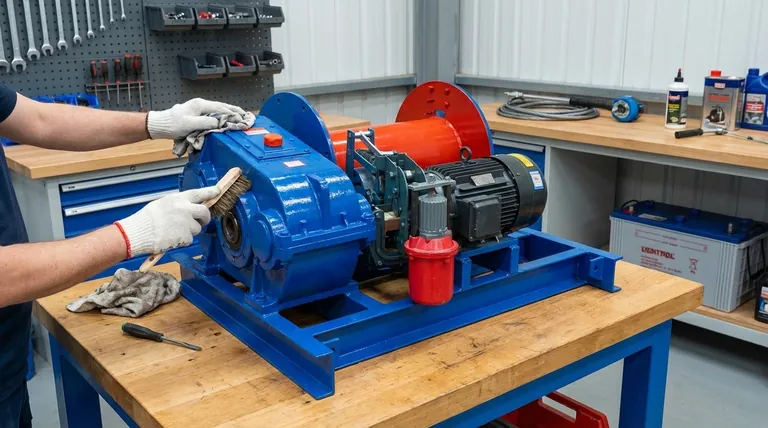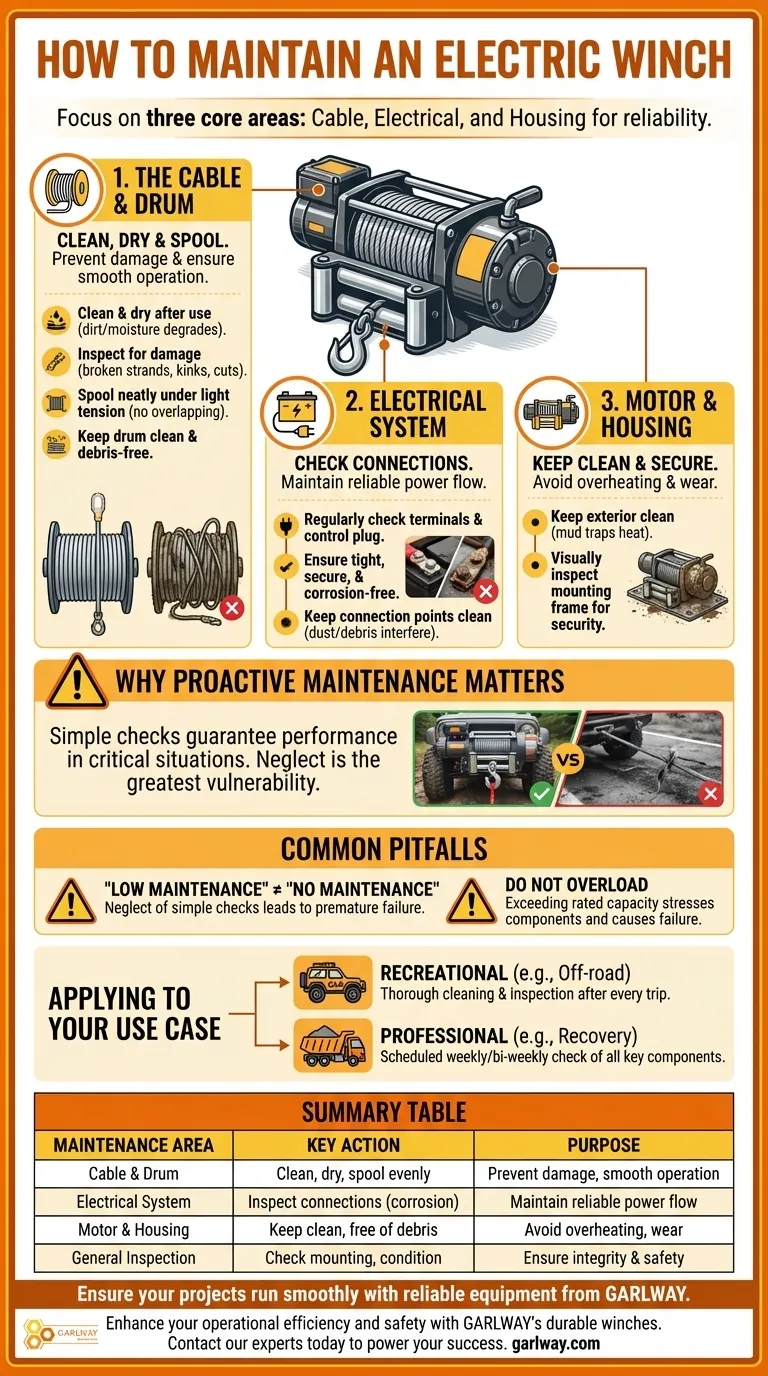To properly maintain an electric winch, focus on three core areas: keeping the cable clean, dry, and spooled correctly on the drum; regularly inspecting all electrical connections for integrity and cleanliness; and ensuring the winch housing and components are free of damaging dust and debris.
While electric winches are valued for their simple maintenance due to fewer moving parts, their reliability in critical situations hinges entirely on consistent visual inspection and basic care. The primary goal is not complex mechanical work, but ensuring readiness.

Why Proactive Maintenance Matters
An electric winch is designed to perform demanding work, often in harsh environments like off-road recovery or industrial loading. Its components—a motor, gearbox, drum, and cable—are built for strength.
The relative mechanical simplicity of an electric winch means it doesn't require frequent oil checks or intricate lubrication. However, this simplicity can lead to neglect, which is its greatest vulnerability. Consistent, simple checks are what guarantee performance when you need it most.
A Systematic Maintenance Checklist
A component-by-component approach is the most effective way to ensure nothing is overlooked.
The Cable: Your Primary Connection
The winch cable, whether steel or synthetic, is the most exposed component and requires the most attention.
After use, ensure the cable is clean and dry before spooling it back onto the drum. Dirt, sand, or moisture can degrade the cable and damage the drum over time.
Inspect the entire length of the cable for damage. Look for broken strands or kinks in steel rope, and abrasions or cuts in synthetic rope.
The Drum: The Heart of the Spool
The drum's condition directly affects the life of your cable.
Always ensure the cable is spooled neatly and evenly onto the drum under light tension. Messy or overlapping spooling can pinch and damage the cable.
Keep the drum itself clean and free of any debris that could snag or abrade the cable as it winds.
The Electrical System: The Source of Power
A winch is useless without a reliable power source.
Regularly check all electrical outlets and connections, including the battery terminals and the control box plug. Ensure they are tight, secure, and free of corrosion.
Keep these connection points clean of dust and debris, as contaminants can interfere with the electrical current.
The Motor and Housing: The Protective Shell
The housing protects the motor, brake, and gearbox from the elements.
Keep the exterior of the winch clean, especially around the motor. Mud and grime can trap heat, causing the motor to overheat during heavy use.
Visually inspect the winch's mounting frame to ensure it is securely fastened to the vehicle or structure.
The Pitfall: "Low Maintenance" is Not "No Maintenance"
The greatest risk in owning an electric winch is complacency. Because they lack the complex fluid and lubrication needs of other systems, they are often forgotten until they fail.
The Danger of Neglect
Neglecting the simple checks—cable condition, electrical integrity, and proper spooling—is the leading cause of premature failure. A frayed cable or corroded connection will fail under load.
The Impact of Overloading
Maintenance cannot fix damage from improper use. Always operate within the winch's rated load capacity. Exceeding this limit puts extreme stress on the motor, gearbox, and cable, leading to catastrophic failure and significant safety risks.
How to Apply This to Your Use Case
Your maintenance frequency should match your usage patterns.
- If your primary focus is occasional recreational use (e.g., off-roading): Perform a thorough cleaning and inspection after every trip, paying special attention to the cable and electrical connections.
- If your primary focus is frequent professional use (e.g., vehicle recovery, industrial jobs): Implement a scheduled weekly or bi-weekly check of all key components, even if the winch hasn't been used.
Consistent, simple checks are the key to ensuring your winch works flawlessly when you need it most.
Summary Table:
| Maintenance Area | Key Action | Purpose |
|---|---|---|
| Cable & Drum | Clean, dry, and spool evenly | Prevent cable damage and ensure smooth operation |
| Electrical System | Inspect connections for corrosion | Maintain reliable power flow |
| Motor & Housing | Keep clean and free of debris | Avoid overheating and component wear |
| General Inspection | Check mounting and overall condition | Ensure structural integrity and safety |
Ensure your projects run smoothly with reliable equipment from GARLWAY.
As a specialist in construction machinery, we provide durable electric winches, concrete mixers, and batching plants designed for the demanding needs of construction companies and contractors worldwide. Proper maintenance is key, but it starts with quality machinery.
Let us help you enhance your operational efficiency and safety. Contact our experts today to discuss your specific requirements and discover how GARLWAY's solutions can power your success.
Visual Guide

Related Products
- Electric and Hydraulic Winch for Heavy Duty Applications
- Electric 120V Boat Winch by Badlands
- 12000 lb Heavy Duty Electric Boat Winch
- Electric Hoist Winch Boat Anchor Windlass for Marine Applications
- Heavy Duty Electric Boat Winch Windlass Anchor
People Also Ask
- Can you use an electric winch manually? A Guide to Dual-Functionality Winches
- How is an electric winch powered? Unlock the Power Conversion System for Heavy Lifting
- How do I choose an electric winch? A guide to safe and effective pulling power.
- Can an electric winch be used as a hoist? Understand the Critical Safety Differences
- How long can you run an electric winch? Master Safe, Efficient Vehicle Recovery



















